Tea Chemistry
Organic or Non-Organic Tea?
A question we often receive at Simply Tea is why our teas, if they are organic, do not carry an organic label.
For formal reasons, which we will attempt to explain below, our teas cannot be labeled as organic, among other things, because there is no certification system and quality guarantee that applies worldwide.
The Danish Food Authority checks our teas when they arrive in the country. For each shipment of tea we receive, 20 percent is randomly selected for analysis for around 29 different pesticides. As expected, all our teas have passed the inspection smoothly, with no pesticide residues found.
Certification
Even though we do not have the red organic label, all our teas are sustainably grown. No pesticides, growth hormones, artificial fertilizers, or similar substances have been added. We have certificates confirming that they are approved by the USDA, the American food authorities, which are among the strictest in the world, as well as by the Chinese food authorities, which are also very stringent. However, because they are not certified by Ecocert, with which Denmark and many EU countries have partnered, we cannot put the red organic label (or any other EU organic labels for that matter) on them. Ecocert certificates are required for that.
Spring Harvest Snatched Up in an Instant
A few of our tea gardens do not have certificates, even though they are sustainably grown. In China, certifications do not hold the same significance as in the West. High-quality teas are so rare that they are only harvested for six weeks a year, and the annual production of these teas is between 300 and 500 kilos per garden.
In the Chinese context, it costs exorbitant amounts to become certified, and for a small family-run tea garden, the annual profit can be eaten up by a visit from authorities and a stamp that holds no real significance. Whether certified or not, these teas are snatched up every spring as soon as the last leaves are picked and the last bag is sealed.
Tea wholesalers camp in the backyard, waiting with stacks of cash to leave with the annual harvest in their bags.
In other words, the rare teas that Simply Tea imports never reach the commercial market, as they are purchased on-site. That is why it is so important to be present when the harvest is in.
However, the large, well-known commercial tea companies are not interested in these teas at all, as they can only buy very small batches from small, scattered gardens located far from cities and industry in difficult-to-access areas high in the mountains.
Seven Cups
Furthermore, Simply Tea has had a close and fruitful collaboration with the company Seven Cups for 10 years. Seven Cups is our guarantee that the teas are sustainably grown. Austin and Zhuping Hodge, the founders of the company, have dedicated their lives to tea and to maintaining the high standard in the import of rare and sustainable teas from gardens they personally select each year. Only the best of the best is allowed to pass through their critical eye.
Additionally, there is another important aspect: Access to these gardens is not something one simply receives. Many of them are former tribute tea gardens* (where the emperor was honored with the best tea that could be produced), where many cups of tea are consumed before purchasing to achieve the ‘approval stamp’: the tea master’s trust that one understands and respects the specialization involved in producing these rare teas.
Visiting Tea Gardens Every Year
This is one of the reasons why we, together with Seven Cups, travel to China every year to visit the tea gardens and nurture the good relationships. Here, we also see for ourselves that the teas are not sprayed. How can we tell? For this purpose, ferns are an incomparable indicator. If ferns grow among the tea plants, no substances other than natural fertilizers have been added. Ferns are extremely sensitive to toxins, and they die or completely disappear if there are toxins in their vicinity.
According to the Chinese, food and drink – not least tea – play a role in determining who we become and in keeping illness and ailments at bay.
You Are What You Eat and Drink
Contrary to what many here believe, we have learned through many years of travel that the Chinese are exceedingly concerned about what they eat and drink. In fact, they are more convinced than any other people in the world, including us Danes, that you are what you eat and drink.
Our passion at Simply Tea is to import pure teas and provide European consumers access to unique and wonderful flavor experiences that come with these rare teas. No one is more eager than we are to be able to label the teas and thereby prove that they rank among the best in the world. However, as mentioned, it costs the tea farmers enormous sums of money, and people in China are lining up to buy the teas, Ecocert certificates or not.
The tea farmer simply wishes to be allowed to deliver the noble harvest and continue the proud artisanal traditions passed down through centuries. And we support them in every way we can.
*Tribute Tea Garden: The first tribute garden ever established in China was initiated by Lu Yu, who is also the man behind the world’s first tea book. He established the garden with Purple Bamboo green tea as a tribute garden for the emperor, believing it to be the best tea in the world. Today, the former tribute gardens still exist, and tea from these gardens is reserved for the government, party leaders, and foreign heads of state. Selected entities, including Seven Cups and Simply Tea, have access to purchase tea from these gardens.
Brewing Time
Q: The brewing times for tea are very important for achieving the perfect cup, but I have noticed that your teas often state “2-3 minutes” or “5 minutes.” Do you have charts for your teas with second/minute brewing times?
A: When we write brewing time on the packaging or on our website, it is because we have brewed it according to European standards, i.e., one gram of tea per deciliter of water. In China, it is common to brew much more tea per deciliter of water, which makes the tea much stronger than most Europeans prefer.
Brewing times are just a guideline for the consumer. Every time we receive a new harvest or a new tea, we brew it multiple times to find the best flavor experience. We take note of the time and the number of times we can brew the leaves without the tea losing its flavor; therefore, our brewing times are very precise for the specific tea.
It would be incorrect for us to say that all green teas should be brewed for a specific number of minutes. There are several green teas that should steep for just a few seconds, while others need to steep for many minutes.
The crucial factor for brewing time is the ratio of sweet amino acids to bitter flavonoids in the tea. If there are many flavonoids in the tea, it will become bitter after a short time, but if there are many amino acids, the leaves will be sweet and can steep for a very long time without needing to be removed.
It is a matter of chemistry. Taste is unique to each individual and depends on how many taste buds one has, how they are distributed in the mouth, tongue, and palate, how our sense of smell is structured, and how the various substances in the tea react with our saliva.
There are 550 different substances in tea that contribute to its flavor. The ratio of these chemicals changes based on the country, the altitude, when, how the tea leaves are harvested, the influence of other plants, weather conditions, minerals in the soil, how the tea is processed, packaging, storage, temperature, brewing equipment, serving cup, quality and temperature of the water for brewing, and not least, the brewing time. Changing any of these factors will alter the flavor, and that is what makes tea exciting; there is no definitive answer. One should strive to brew the best cup of tea every time.
The advantage of Simply Tea’s teas is that we have taken into account the ultimate conditions and found the best teas on the planet. You just need to use the best water and the correct temperature, along with the best equipment – which is porcelain, clay, or glass – never plastic, cardboard, paper, or metal.
The brewing time is a guide to help you make the best extraction that suits your taste buds. If it says 3-5 minutes, start with 3 minutes, and if you feel that you would like more flavor, steep it a little longer until you achieve what you enjoy the most.
How Do I Evaluate the Quality of Oolong Tea?
Q: How can I assess the quality of an Oolong tea based on the appearance of the leaves?
A: The dried leaves of light Oolong teas have a light yellow to dark green color, while the dark oxidized Oolong teas, such as Wu Yi Mountain (Rock Oolong) or Phoenix (Dan Cong), are dark green or brown.
Tie Guan Yin Oolong
It is said that Tie Guan Yin Oolong resembles the head of a dragonfly with a light to dark green color. Anxi Oolong teas are lighter than Taiwan Oolong teas. Oolong teas have larger leaves than, for example, green teas, where the edges of the Oolong leaves are distinctly serrated, which is visible when the brewed leaves unfold in the water.
Pay attention to whether the leaves crumble during brewing. After the tea is brewed, the leaves should be whole, flexible, and fresh in appearance. The leaves should never be tough, old, or thick – this is a sign of a harvest that was too late. Anxi and Taiwan Oolong leaves should be whole when brewed.
Rock and Dan Cong Oolong
The dark Oolong teas may break slightly during the repeated roasting and roasting process, but they should not crumble.
To assist you, you can use Simply Tea’s product descriptions on the webshop as a guide.
It is the aroma, color, and flavor that reveal the quality of Oolong. If the tea retains its flavor after the 5th, 6th, or 7th infusion, it will be considered a tea of fine quality.

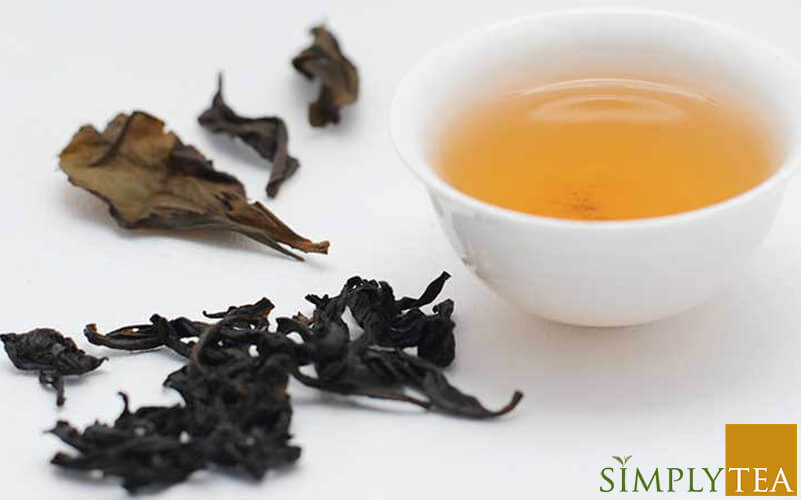
Quality of Water for Tea Brewing
Water Temperature is Crucial
Learn to master the “shrimp eyes,” “crab eyes,” and “fish eyes,” and you won’t go wrong when brewing the perfect cup of tea. This way, you also avoid what the Chinese call “old man’s water.”
The quality of water for brewing and water temperature are critical for the cup of tea you brew and for the flavor and aroma of the tea as a whole.
If you drink white, yellow, green, or light Oolong tea, you know that using the correct water temperature can make a significant difference in whether you end up with a bitter tea or a tea filled with sweetness and aroma like a flower meadow.
When drinking black, Puerh, or dark Oolong tea, you should use boiling water, but we recommend removing the kettle just before it starts to boil to avoid the water losing oxygen and becoming flat.
The Modern Method
You can achieve the correct water temperature in several ways.
You can use a cooking thermometer or an electric kettle with a thermostat to get exactly the temperature you want.
With a little practice, you can also train your ear to hear when to take the kettle off before it exceeds the desired temperature, just as people did before we all had our modern tools like electric kettles, cooking thermometers, etc. Back when we had to rely on sight and sound.
The Traditional Method
When you start boiling water, notice that when the kettle is about to boil, the sound changes, and the steam rises faster and becomes more intense.
As the water gets warmer, small bubbles the size of a pinhead begin to “pop” up to the surface of the water. The Chinese call this “shrimp eyes.”
"Shrimp Eyes"
60-70 degrees Celsius for fine and delicate green teas.
Slowly, the steam changes, and the sound of the kettle changes to a low hum. The temperature is now at 60-70 degrees Celsius, the perfect temperature for brewing the finest green teas.
"Crab Eyes"
75-85 degrees Celsius for light teas.
The temperature continues to rise, and the bubbles grow to the size of “crab eyes.” The steam now rises vertically in a constant stream, and the kettle begins to make popping sounds. The temperature has now reached 80 degrees Celsius – the perfect temperature for white, yellow, green, and jasmine tea.
"Fish Eyes"
90-96 degrees Celsius for Oolong, Puerh, and black teas.
When the bubbles have grown to the size of “fish eyes,” the sound of the kettle changes to a strong hum and buzz. The steam now rises faster in a thick column. The water is now at 90-96 degrees Celsius, the right and perfect temperature for Oolong, Puerh, and several black teas.
"Old Man's Water"
100 degrees Celsius water is unsuitable for brewing tea.
The final stage – where the sound of the kettle becomes an eager waterfall, and the bubbles dance around each other – is not suitable for tea water.
The Chinese have a telling expression for this; they call it “old man’s water” because it is ‘dead’ and devoid of oxygen, and using it will give the tea a flat and ‘old’ taste.
On all Simply Tea’s teas, you will find detailed instructions and information on how to brew the tea and what water temperature to use for the specific type of tea.
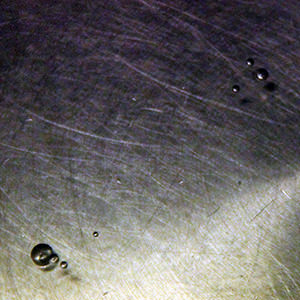

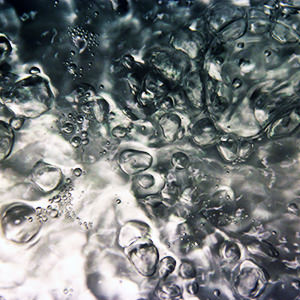
How to Avoid Bitterness in Tea?
There are many factors that contribute to bitterness in tea. It can range from our individual taste receptors in the mouth to the quality of the leaves, as well as how we brew, store, and measure it. The most likely reason for tea being bitter is that the tea leaves were harvested very late in the season, and therefore the flavonoids, which give this bitter taste, are at their peak. Flavonoids are found in many fruits and vegetables. The best example I can give right now is Danish peas in pods. The young, freshly picked peas are sweet but not very large; if you wait until they fill the entire pod, they lose their sweetness and the taste becomes bitter. Tea harvested late in the season is often more bitter than tea harvested early. Most commercial teas are harvested late to get the largest leaves possible, focusing on quantity over quality. These teas are often flavored with various additives, aromas, fruits, and flowers to mask the bitterness.
Bitterness can also be caused by water that is too hot or by steeping the tea for too long. If you follow the brewing instructions on the package, the result should be a tea without bitterness. Incorrect measurement of leaves can lead to a very strong brew, which can also be perceived as bitter; therefore, it is recommended to weigh the tea at the beginning. One gram of tea per deciliter of water is the standard. However, there is a significant difference in volume; white tea takes up much more space than black tea. Tea that is not stored properly or is too old can also become bitter, so it is important to store tea tightly to protect it from oxygen, moisture, light, heat, or cold.
Machine-processed tea is often more bitter compared to hand-processed tea. The chemical processes are easier to control with hand processing. All tea bag teas are CTC machine-made. High-quality tea is rarely bitter for the simple reason that it is harvested early in the spring from high-altitude mountains. When tea plants are grown on mountain slopes at several thousand meters of altitude, special amino acids develop, which contribute to the tea’s sweetness and umami. Hand processing of tea means that the tea master can adjust for the natural chemical processes caused by heat and humidity, just as a baker can control bread. Quality teas are a craft, which is why they are often quite costly. A tea that is painstakingly hand-crafted is good for many infusions by reusing the same leaves. These teas, compared to commercial teas, are quite competitive.
The short answer, if you want the best tea experience, is to buy quality tea that is harvested early in the spring and is hand-processed. Brew the tea according to the instructions and store it tightly. This way, you are assured of a good tea experience without bitterness. For beginners who want to try a gentle tea without any bitterness, I can recommend the following teas:
Shu Puerh
Shu Puerh is a pre-fermented tea that allows for many brews, but the taste never becomes bitter or strong, regardless of how long the leaves are allowed to steep.
Goddess of Mercy Oolong
Goddess of Mercy Oolong is great if you are unsure about water temperature or steeping time. You simply cannot make it wrong. The tea is good for 4 to 5 brews.
Bai Mu Dan White Tea
Bai Mu Dan white tea, due to its processing, has a natural floral aroma and fruity taste that never becomes bitter. Perfect for a warm summer day.
Tea Tasting
If you would like to taste more types of tea, you can sign up for Simply Teas’ tea tasting courses. Read more here.
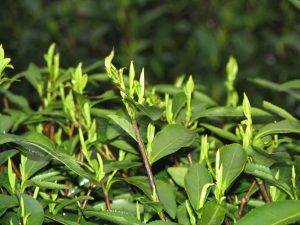
Larger tea leaves contain more flavonoids.
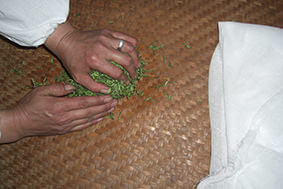
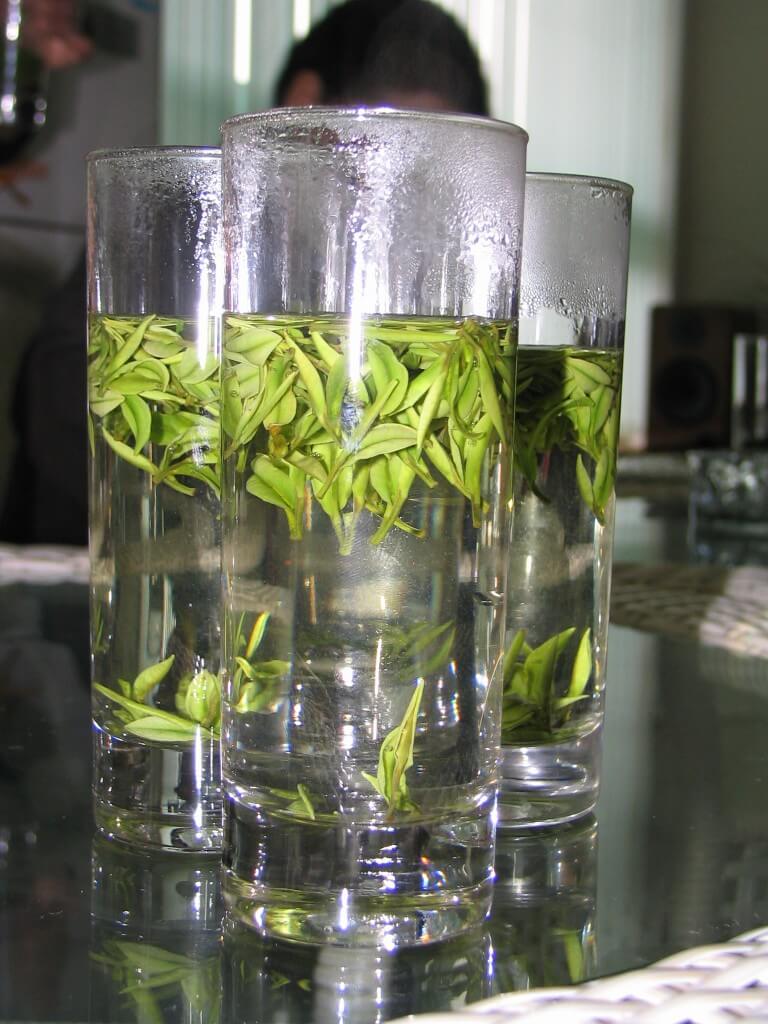
Can tea cause iron deficiency?
The short answer is no. If you are healthy and eat a varied diet, tea will not result in iron deficiency. The absorption of iron is influenced by several factors: how many iron-rich foods you eat, whether you consume animal products like meat, eggs, or fish – and plant sources, including grains, legumes, nuts, and dried fruits, as well as your physiological condition. Are you pregnant or menstruating?
Scientists believe that the polyphenols in tea can reduce the absorption of iron from plant foods, but studies do not provide sufficient evidence to suggest that tea causes problems in healthy individuals.
If you suffer from iron deficiency or are at high risk for it, wait at least an hour after a meal before drinking tea. Vitamin C helps the body absorb iron, so enhance your cup of tea with a squeeze of lemon juice.
What is a Japanese tea ceremony?
A Japanese tea ceremony is an artistic way of being together, where the ritual surrounding the preparation and consumption of matcha tea is the central focus.
Tea came to Japan from China in the 8th century, but it was not until the 12th century that matcha tea was introduced.
It started as a social event where friends would gather to drink matcha tea. It later spread to the upper social classes in the 14th century. Gradually, one of the main purposes of gathering and drinking matcha became to appreciate art and craftsmanship in an elevated atmosphere.
A Japanese tea ceremony – in Japanese called chanoyu (茶の湯) or chadō (茶道) – is a choreographed ritual, a way to serve matcha tea. The ceremony also includes special Japanese sweets that are eaten to balance the bitterness of the matcha.
When preparing the tea, one devotes their full attention to carefully studied movements. It is not just about drinking tea, but rather the aesthetics surrounding the process and preparing a bowl of tea with heart. In each movement, the ceremony master considers the guests present. Each tool is placed from the guest’s perspective.
The tea ceremony is an art form and a spiritual experience. It is a way to appreciate the simplicity and arrangement of the tea room, a way to feel the chawan (the special bowl from which matcha is drunk) in hand, and a way to be together with friends in a peaceful moment.
As a discipline, it also involves an aesthetic sense for arranging flowers, knowledge of porcelain and tea utensils, calligraphy, and the ability to prepare a special meal (Kaiseki), as well as understanding the strict rules for seating guests based on rank and title.
The Goal
The goal of a Japanese tea ceremony is to create a relaxed atmosphere between the host and their guests.
It is partially based on the etiquette surrounding the serving of tea (temae), but it is closely connected to architecture, garden art, the use of special tools for preparing matcha, art, porcelain, and Zen Buddhism, in addition to a number of other elements that form the foundation of a Japanese tea ceremony.
On a deeper level, the goal is to achieve a deep spiritual satisfaction through the consumption of matcha and a quiet rest in the ritual. On another level, it is simply a form of gathering where guests are invited to drink tea in a pleasant and relaxed space. It is also a way to strengthen the bond between the host and guests through the host’s preparation and serving of matcha tea.

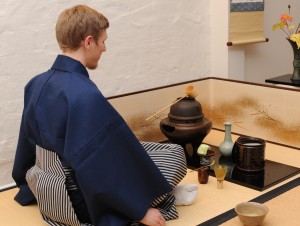
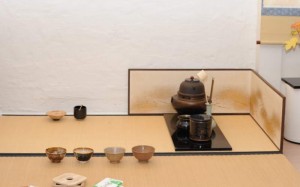
The difference in the preparation of white tea and green tea
One of the major differences between white and green tea is the way they are processed.
To make white tea, the buds and leaves are picked together. The leaves and buds are then separated and sorted into three different grades, which become four different teas – including Bai Hao Yin Zhen (Silver Needle) and Bai Mu Dan (White Peony), as well as two others called Shou Mei and Gong Mei.
The preferred method for drying white tea is in the sun, as it is the fastest. However, there is rarely enough sunshine for this to be feasible.
In contrast to green tea, where the leaves are exposed to relatively high temperatures to stop enzymatic activity and reduce as much moisture as possible, white tea is dried in the sun or indoors at lower temperatures to preserve the polyphenols. It takes about 40 hours to dry them and requires the constant and careful monitoring of the tea master, who feels the leaves to determine when they have dried long enough to be declared ready for packaging and sale.
Like green tea, white tea is considered to have a cooling effect on the body according to traditional Chinese medicine. In particular, Silver Needle is regarded as being very effective in this regard.
White tea is also used to combat fever and infections, prevent dental issues such as periodontal disease and cavities, and address skin problems.
In rural areas of China, it is quite common to let Silver Needle sit for four to six years to achieve the medicinal effects of the tea. From Western medicine, we also know that one of the health-promoting aspects of white tea is its high concentrations of antioxidants.
Studies show that certain catechins, such as EGCG, are higher in white tea than in green tea. There is a lot of research being conducted on the effects of specific catechins on the body, but so far, there is no scientific evidence in humans that these teas are healing.
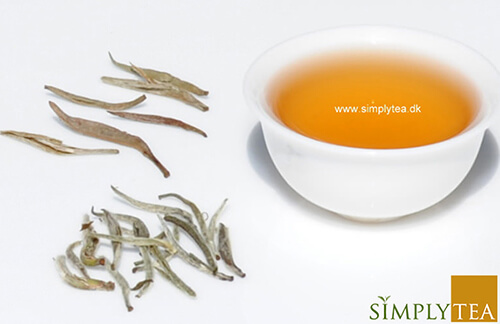
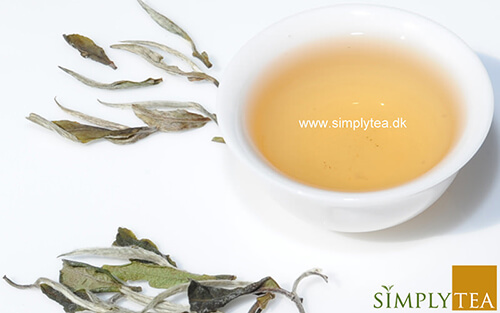
What is a cultivar?
A cultivar is a word composed of “cultivated variety.” These particular cultivated varieties are often terroir-specific and have developed over time. The plants develop special abilities to grow in exposed locations, such as at very low temperatures or in areas with significant drought, etc., and this affects the flavor.
We see this with apples in Denmark. If you plant a seed from an apple, you will not know what kind of apple it will produce until it bears fruit, because the seed’s DNA contains many genes from various other apples. If you want a specific apple, like “Inge Marie,” because of its flavor or color, you will need to take a cutting from the parent tree that already produces Inge Marie apples. In this way, you create a copy of the plant’s DNA. This is called a cultivar and has been known in agriculture for hundreds of years.
A cultivar has nothing to do with GMOs. A GMO, or genetically modified organism, is a plant, animal, microorganism, or other organism whose genetic DNA has been modified in a laboratory using genetic engineering or transgenic technology. A cultivar is nature’s way of developing a specific survival trait, color, flavor, or aroma, which we humans have copied by cultivating cuttings.
What is Kabusecha?
Kabuse
Several Japanese tea producers cover their teas with bamboo, rice, or cloth mats for 7-20 days before they are harvested. This process, known as “kabuse,” helps to stress the plant and forces it to produce large amounts of L-theanine. L-theanine, which is found only in tea and a single species of mushroom, is the most sought-after component in tea. It is what tea enthusiasts look for because it gives the tea its sweet flavor and the long, rich aftertaste known as “umami,” as well as an indescribable sense of well-being.
Sencha is probably Japan’s most popular tea, while gyokuro and sincha are more exclusive. Matcha is ground into a very fine powder and is often used in tea ceremonies. Kabuse means that the tea has been grown in partial shade.
Kabuse teas are cultivated by covering the plants as soon as the new leaves begin to peek out in April. This encourages the leaves to produce up to 85% more broad, soft, and chlorophyll-rich leaves.
When the leaves are ready to be harvested, a significant amount of handwork follows. Immediately after the fresh leaves are picked, they are cooled to about 5ºC. They are then treated with heat in the form of steam to stop oxidation. The large temperature difference is said to shock the leaves, producing the unique round flavor of seaweed that characterizes Japanese teas.
Now the leaves are ready to be sorted by hand. In the first sorting, twigs and small branches are removed. The leaves are then rolled four times. The first and second times with dry heat, and the third and fourth times while the leaves are being cooled. Finally, the leaves are dried once more—this time gently at 70ºC for 15 minutes.
The final hand sorting takes place with the help of the eye. Here, the leaves are categorized by color and size using a “sieve.” The second and final sorting is done in a wind tunnel. The best leaves are selected, which are those that have a “heavy, dark leaf.”
The flavor that characterizes Kabuse tea is a slightly spinach- and seaweed-like taste, which also has a delicate sweetness and a mild sharpness. These flavors balance beautifully with each other.
Preparation of sencha, gyokuro, and sincha
- Amount: 2 g per 200 ml of water.
- Water temperature: 50-70°C.
- Steep for 10 seconds
- Steep for 30 seconds
- Steep for 3 minutes
